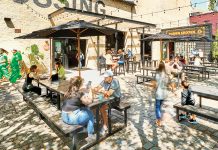My story last month about the glut of restaurants in Minneapolis and St. Paul was a little too anecdotal for my taste, so I decided to get some hard data. Nationally, there’s been some writing by Kevin Alexander of Thrillist, discussing the glut of restaurants, and this line jumped out at me about the decline in business for restaurant AQ in San Francisco, which opened in 2011: “Maybe it’s because there were 3,600 restaurants in SF when it opened, and now the SF Environmental Health Department puts that number at 7,600.”
The city of Minneapolis issues licenses for restaurants without liquor (fast food, coffee shops, old-school diners) and for restaurants/bars with liquor, wine and beer, as well as tap rooms and distilleries. It gives a nice way to see what’s been happening in the city since 2001.
The number of restaurant licenses without booze has stayed fairly consistent since 2004: we average 564. So the real change is in restaurants with alcohol. I admit this data includes bars without food, but I’d argue that number is fairly constant since 2001 as well.
In 2001, Minneapolis had 368 on-sale liquor and wine licenses. In 2016 the city issued 670 licenses. That’s an 82% increase. Part of it are alcohol-focused venues—29 of them are beer or cocktail tap rooms. But even if you take those out, you still have a 74% increase in 15 years. Certainly we’re eating out more today than we were in 2001, but are we eating out that much more? Here’s what the data from the city of Minneapolis shows:

Over the past five years, there has been a 32% increase. And this doesn’t include all of the food trucks that operate seasonally. If you add the 559 non-liquor restaurants into the total for 2016, Minneapolis ended the year with 1229 restaurants. That compares to 1022 in 2004.
It’s harder to get historical data for St. Paul, since the restaurant inspections in that city have been taken over by the state. There are 1019 establishments with food licenses right now, but that includes pools, camping areas, youth camps, all sorts of things. That number was 957 last year, according to this Pioneer Press article, just a 6% increase. But St. Paul has a cap of 200 licenses for hard liquor, and those are almost always taken, so that does keep a lid on restaurant expansion in that town. You tend to see more substitution: one spot closes, another owner grabs the liquor license.
Back to the Thrillist article. Restaurants are always changing and adjusting with the times, and that’s not a bad thing. We’re seeing a huge interest in delivery, and in some cities, chefs are opening up kitchens designed to specifically serve take-out. No seats, little overhead, just order and get it delivered. Cool, right? Alex Roberts was on the front end locally of the movement of great chefs opening fast-casual spots—I’d argue that Brasa is as excellent as Alma is. Some restaurants will be giant cash generators (Cossetta, Manny’s) and some will fight to break even.
To a certain degree, we as diners expect the impossible: we want everything in the kitchen to be made from scratch, we want locally-sourced and sustainably-raised food, we want great service and cool decor, and we want to pay $10 for a burger. It’s unrealistic. And the trendline from the Minneapolis data is clear—after living around 500 restaurants with liquor licenses from 2005-2011, we’ve been on a steady climb. We don’t have enough workers willing to staff these places at current prices. So pay people more? As long as you’re willing to keep paying more for your drinks and your burger.






